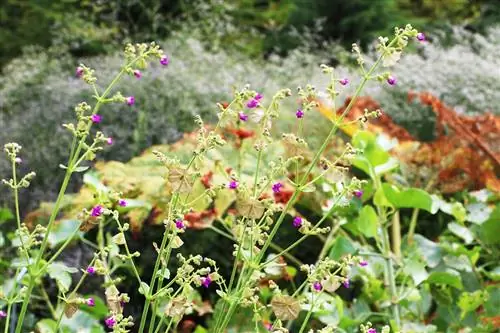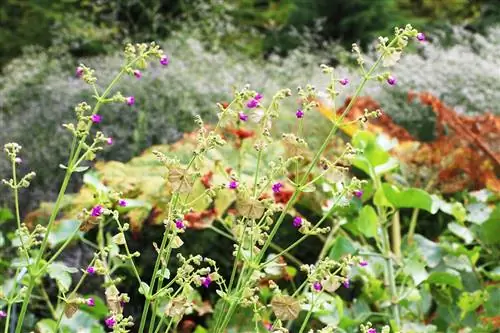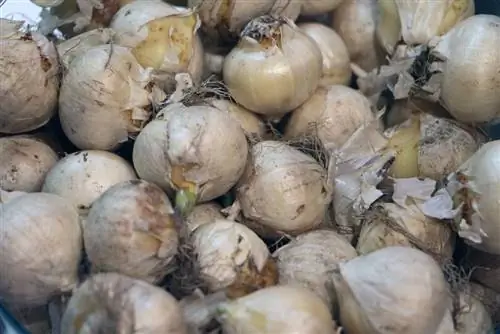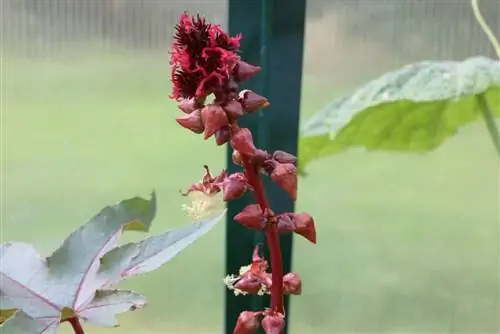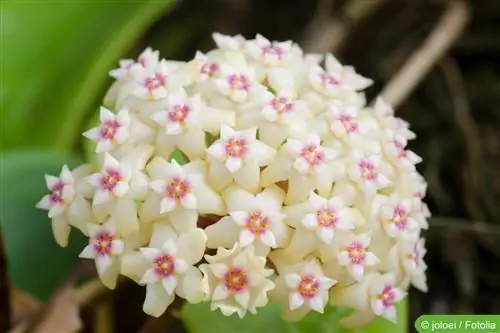- Author admin [email protected].
- Public 2023-12-17 03:39.
- Last modified 2025-01-24 12:45.
The miracle flower lives up to its name! You can discover up to five different flower colors on a single specimen. If you follow our care tips, you can enjoy the splendor of the flowers every summer.
Profile
- Botanical name: Mirabilis jalapa
- Family: Miracle flower family Nyctaginaceae
- Location: sunny
- Substrate: fresh, sandy, humic
- Height: 60 to 100 centimeters
- Flower color: white, pink, yellow, orange, red or multicolored
- Flowers: round, pleasantly scented
- Leaves: oval to round, slightly pointed
- Use: flower borders, potted plants, cut flowers
- Hardy: no
Flower Wonder
The miracle flower (Mirabilis jalapa) comes from America. It probably owes its name to the fact that flowers in several colors can appear on a single perennial. Up to five colors are possible. The flowers only open in the late afternoon. Then they give off a pleasantly fresh orange scent. The flowers remain open until the early hours of the morning. It is often visited by moths and hawkmoths. In the morning the panicle flowers close again. The flowers fade quickly. However, this is not noticeable because new ones are constantly appearing.
Note:
Remove the spent flowers regularly. This way you stimulate flower formation and the plants always look attractive.
Location & Substrate
A sunny, wind- and rain-protected location offers the best conditions for the perennial. We recommend using humus-rich, slightly sandy substrate. In order for the flowers to develop, Mirabilis jalapa needs nutrient-rich soil. Provide the plant with fresh compost in spring.
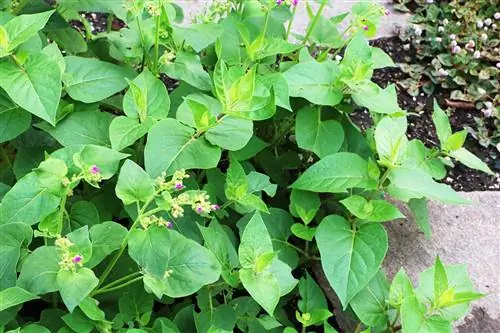
Sowing & planting
The miracle flower can be sown directly outdoors from the end of April. In colder regions we recommend sowing in March in seed trays. Cover the containers with foil so that the small plants can develop well. Avoid direct sunlight so that the sensitive cotyledons do not burn.
Pick out the seedlings when the first four leaves appear. Place the plants individually or in pairs in small pots. From the end of May, after the Ice Saints, they can go outdoors.
Alternatively, you can purchase young plants or tubers from nurseries.
Planting instructions:
- Dig planting holes 50 to 60 centimeters apart. The plants need a lot of space to develop their beauty.
- Mix the excavated material with horn shavings and compost soil.
- Put the miracle flower flat.
- Only cover the roots lightly with soil.
- Water the perennial carefully.
Note:
If you plant the miracle flower in a pot, fill the bottom with a thick drainage layer. Use containers with large vent holes.
Pouring
During the flowering period, the miracle flower needs regular watering. On dry days, water the plant in the morning and evening.
Avoid waterlogging.
Fertilize
In order for Mirabilis perennials to bloom for many weeks, an adequate supply of nutrients must be ensured. Adding compost in the spring gets you off to a good start. Add flower fertilizer to the water weekly during flowering.
Propagation
Miracle flowers have a tuberous, easily divided rhizome. Divide the plant in autumn and plant the tubers in the bed in spring.
Propagation by seeds is also possible. Collect the seeds from the spent inflorescences. Dry these on kitchen paper. Sow the miracle flowers in seed trays in March or directly outdoors at the end of April.
Wintering
Mirabilis jalapa is not hardy. Please note our instructions for wintering:
- Dig up the root tubers with a digging fork when all the leaves have turned yellow. The best time is in autumn before the first frost.
- Cut off the foliage with sharp secateurs.
- Fill a container with sawdust or dry sand.
- Put in the miracle flower bulbs.
- Place the container in a dark place in the basement. We recommend a temperature of five to ten degrees Celsius for wintering.
Diseases & Pests
Miracle flowers are very robust. They are rarely attacked by aphids. Moisten the leaves regularly with a mixture of milk and water in a 1:2 ratio. The milk-water mixture has a preventive effect against aphid infestation. With good care, illnesses hardly occur. However, if miracle flowers are weakened by waterlogging or long drought, even the robust plants can become sick and die.
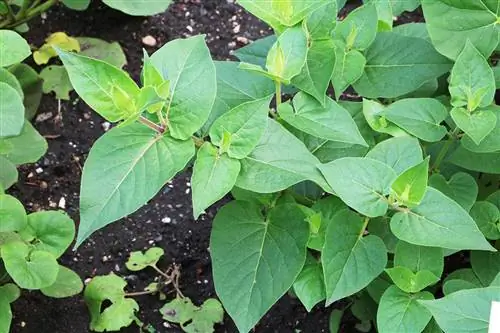
Planting partner
Create colorful flower beds with the decorative perennials. Combine different Mirabilis varieties with each other and let yourself be enchanted by a sea of flowers. Miracle flowers have a great effect in contrast to blue or violet flowers. Next to blue delphiniums or vanilla flowers, you can perfectly showcase Mirabilis Jaspals. Herbs such as rosemary also make the flowering plants shine and at the same time ward off pests.
Usage
Miracle flowers are an eye-catcher in the garden. Not only do people enjoy the flowers, they attract many beneficial insects. Since the flowers are open from the afternoon until the early morning hours, Mirabilis jalapa is considered a valuable food plant for moths.
Tip:
Plant miracle flowers in pots. The heat-loving perennials are ideal for balconies and terraces. When you sit down at the coffee table after work, you can enjoy the flowers and the delicate scent of oranges.

